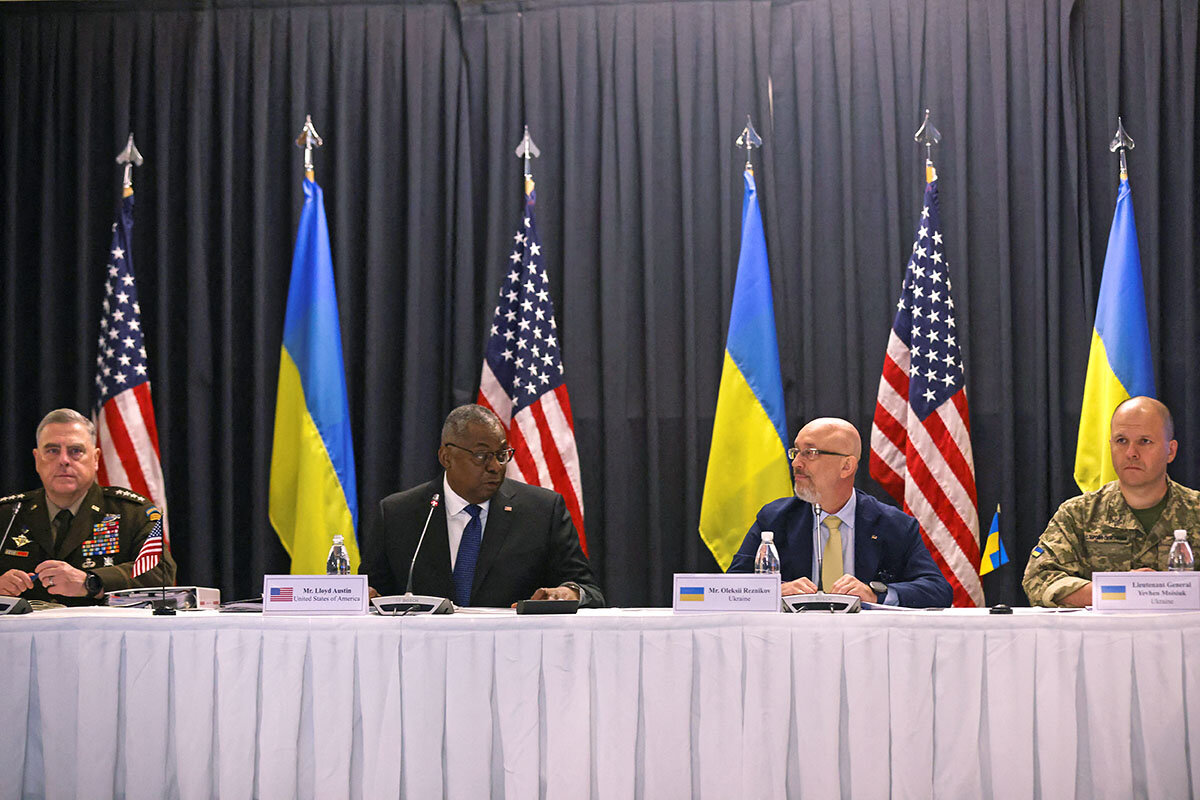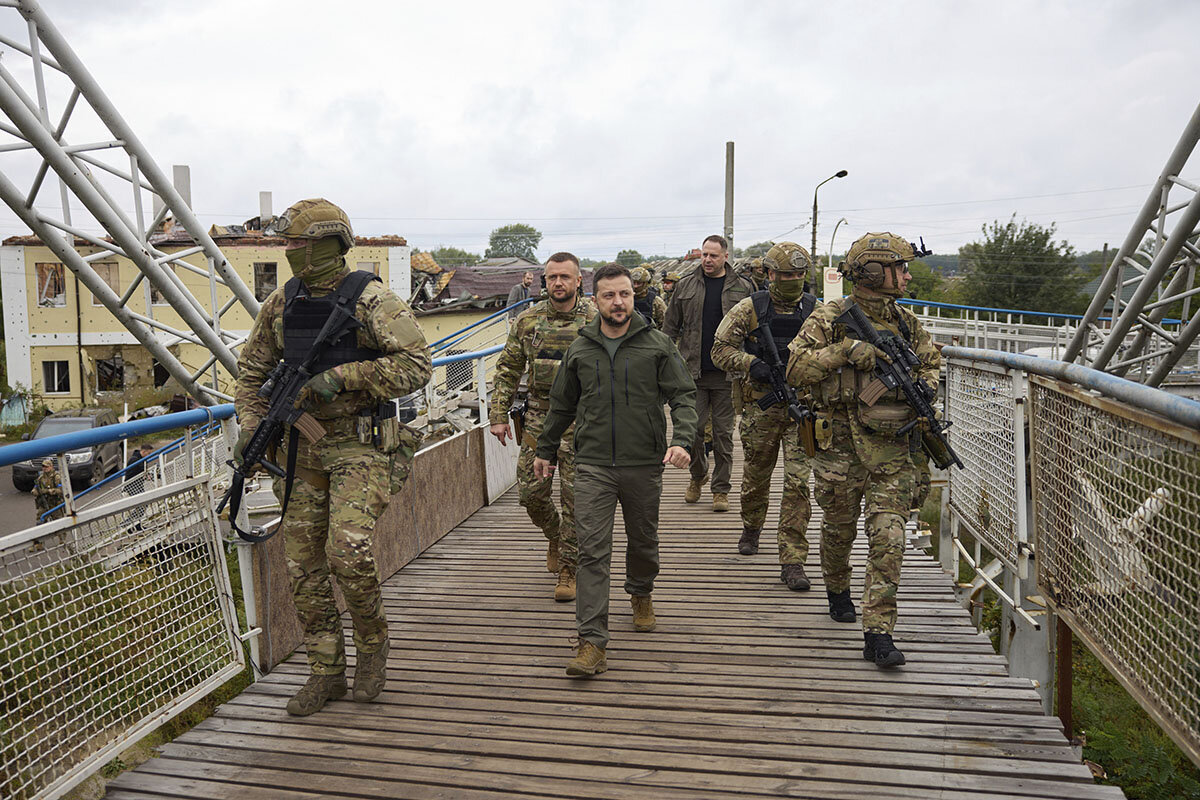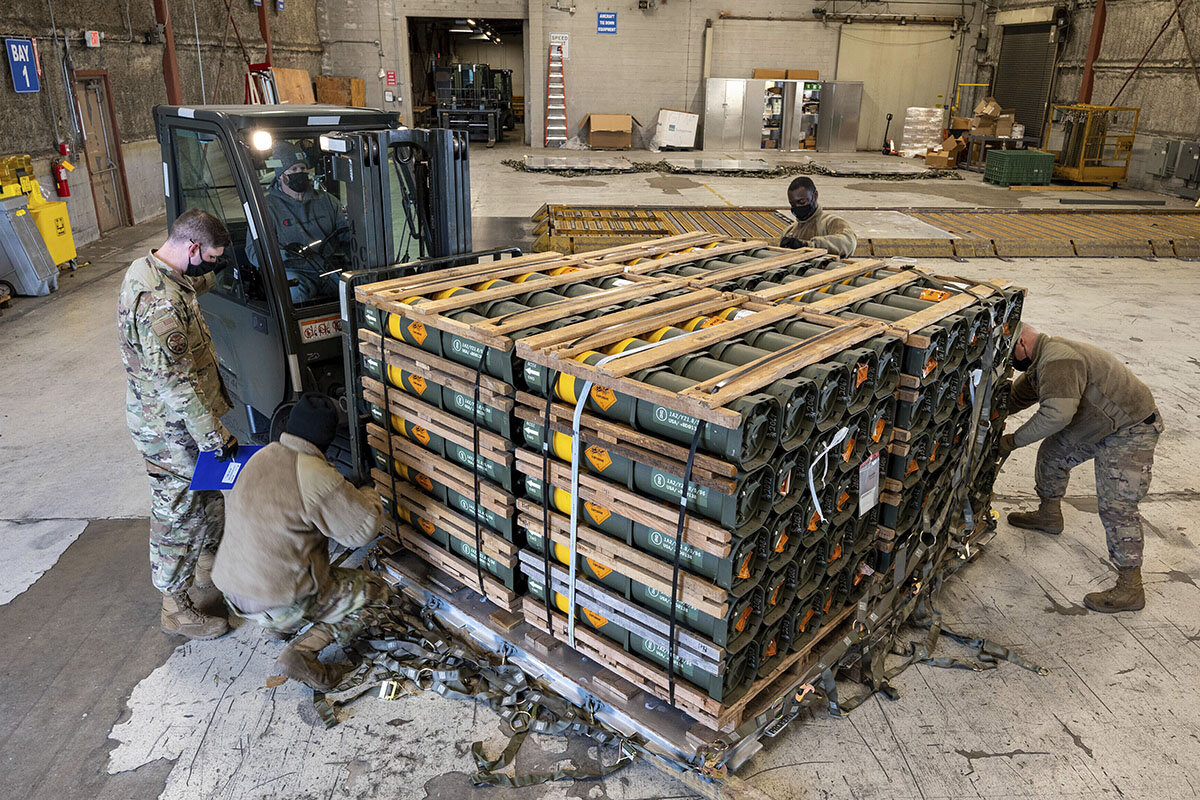Could Ukraine win this war? Answer hinges partly on NATO allies.
Loading...
| RAMSTEIN AIR BASE, GERMANY
Ukraine’s surprising successes in battle are raising a question, at least cautiously: Instead of a protracted war of attrition, can Ukraine hope for turning points toward outright victory, sooner than in the distant future?
The answer may hinge on persistence, not just by Ukraine’s soldiers but also by its allies.
Why We Wrote This
A story focused onRecent military gains underscore Ukraine’s aspirations for victory against Russia's invasion. Achieving that goal may depend on perseverance by NATO allies, too.
The NATO alliance, for one thing, must sort out its own debates about whether Kyiv should get the kind of heavy-duty armaments that could hasten the war’s end, but could also raise the risk of catastrophic escalation.
While President Joe Biden believes the United States should support and defend Ukraine, some critics see a missed opportunity to do more – to “play to win” by sending more and bigger weaponry. The arms flow from the U.S. already has been “unprecedented,” Secretary of Defense Lloyd Austin told a recent gathering in Germany.
Still, a shortage of supplies has been a constant challenge for Ukrainian forces.
If the U.S. and allies show they are ready to persist in helping to supply Ukraine for years, that “hopefully incentivizes Russia to stop fighting and to get down to negotiations,” Colin Kahl, undersecretary of defense for policy, said in a recent Pentagon briefing.
As underdog Ukrainian forces were launching a lightning-strike counteroffensive, for the moment routing their Russian invaders, top military officials from 50 allied nations were mapping out how to bring more weapons – among those they are willing and able to give – to the fight for Kyiv.
A memo outlining “Ukraine’s Urgent Requirements” awaited them as the meeting began. It was a list that ran from the high-tech to the bleakly basic: Rocket launchers were priority No. 1, with artillery and radars rounding out the top three.
Fuel, spare parts, and oil were also among the dire needs.
Why We Wrote This
A story focused onRecent military gains underscore Ukraine’s aspirations for victory against Russia's invasion. Achieving that goal may depend on perseverance by NATO allies, too.
As they strategized, Ukraine’s minister of defense shared updates of the offensive with U.S. Defense Secretary Lloyd Austin, who later assured the gathering that Ukrainian soldiers were “putting the military aid that we’ve all been sending them to immediate and effective use.”
From the United States, this has amounted to an “unprecedented” $14.5 billion since the war began, the latest tranche representing the 20th drawdown from U.S. stockpiles.
In the face of Ukraine’s stirring perseverance and frankly surprising success, Pentagon officials are now promising years of supplies to come – which will be relevant, they say, even in the wake of a settlement.
With these developments, talk is cautiously shifting from acceptance of a protracted war of attrition to the possibility of turning points in a time period sooner than the distant future.
The question in the months ahead, analysts say, will be whether U.S. and NATO allies – with populations facing crushing energy costs as winter approaches – can continue to match the resolve shown by Ukrainian soldiers.
The answer hinges in part on sorting out debates within the alliance about whether Kyiv should get the kind of heavy-duty armaments that could hasten the war’s end, but could also raise the risk of catastrophic escalation.
The answer may also hinge on what Russia and President Vladimir Putin do. On Tuesday, officials in Russia-controlled regions of eastern and southern Ukraine said they plan to start voting this week on joining Russia. Were Moscow to annex those areas, attacks on them would be seen by Mr. Putin as an attack on Russia itself.
While President Joe Biden believes the U.S. should “support and defend” Ukraine, “another key goal is to ensure that we do not end up in a circumstance where we’re heading down the road towards a third world war,” national security adviser Jake Sullivan said in July.
Critics of such caution take issue with the ethics of helping Ukraine defend itself rather than “playing to win.” The longer the war drags on, some argue, the more lives are likely to be lost.
President Putin, for his part, is betting that Western resolve will ultimately splinter in the face of such contentious questions.
“His theory of victory is that he can wait everybody out: He can wait the Ukrainians out because they will be exhausted and attrited,” Colin Kahl, undersecretary of defense for policy, said in a recent Pentagon briefing.
“He can wait us out because we’ll turn our attention elsewhere. He can wait the Europeans out because of high energy prices.”
To this end, making it clear that allies will keep the tranches of military aid flowing is “extraordinarily important,” Dr. Kahl argued, in “challenging Putin’s theory of the case – which is that we’re not in it for the long haul.”
In so doing, he added, allies just might be able to more quickly bring Russia to the negotiating table.
Morale-boosting weapons
To date, the influx of weapons has been pivotal not only to the fighting effectiveness of Ukrainian troops, but also to their morale, which is no small matter – famed military strategists from Hannibal to Joan of Arc have long insisted – in enabling outgunned and outnumbered militaries to eke out some stunning victories.
In his own fights, Napoleon had a rough rule of thumb for winning that’s been widely embraced by modern military thinkers: “In war, morale is to the physical as 3 to 1.”
On a recent visit to Ukraine, Rajan Menon, director of the Grand Strategy Program at the Defense Priorities think tank, heard soldiers echo a common refrain: “‘We will prevail, because Russians are invaders. We’re defending our homeland – and by definition we have more morale.’”
Just as Mr. Putin believes the will of the Western coalition will crumble, Ukrainian fighters are sure this is true of the Russians.
“What my Ukrainian friends are absolutely convinced will happen is that little by little, Russians will find it harder and harder to fight this war and will become gradually demoralized,” Dr. Menon says. “So Ukraine ekes out a victory of some sort.”
That said, even the most optimistic Ukrainian commanders figure the fight could go on for three more years, he adds.
“But when they say that, it isn’t followed up by, ‘So we need to settle.’”
Calls to come to the negotiating table, particularly in the midst of an ongoing Ukrainian counteroffensive, present the “practical problem that there’s no negotiation to be had,” says retired Col. Mark Cancian, senior adviser to the International Security Program at the Center for Strategic and International Studies.
“You’d be asking Ukraine to make a deal where they are right now on the front lines, and yes to Russian occupation of 20% of the country at best.”
Still, a shortage of supplies has been a constant challenge for Ukrainian forces even as countries including the U.S. have been taking weapons out of their strategic reserves to give to Kyiv – a move that becomes less popular, and tenable, as stocks run lower.
With this in mind, NATO allies are pledging to mobilize their private sectors with long-term contracts in an effort to ensure a “steady stream of assistance that will stretch out over many months and years,” Dr. Kahl said.
This, in turn, “hopefully incentivizes Russia to stop fighting and to get down to negotiations,” he added.
“If it doesn’t and the fighting continues, then the assistance continues to be relevant. If it does incentivize him to strike a deal, the assistance is still relevant, because Ukraine will have to hedge against the possibility that Russia could do this again.”
Imposing costs on Russia
When asked whether lawmakers would support this aid given the precariousness of the U.S. economy, Secretary Austin expressed optimism in the face of the “broad bipartisan support” to date.
That said, “There’s always an expectation that we are able to lay out the rationale for those requests – and certainly we’ll do that.”
To bolster its case, the administration is arguing that its efforts have already contributed to some not-insignificant wins.
“It’s important to us that Russia pays a cost in excess of benefits they gain from an aggression, so they don’t do it again – and so that other aggressors can take a lesson,” Dr. Kahl said.
“It’s also important to us that Vladimir Putin’s objective of weakening the West and fragmenting NATO actually is turned on its head – that NATO emerges stronger,” he added. “I think we’re on track to achieve ... those objectives.”
As the fighting continues, however, NATO officials are also aware that offensive operations are far more complex than playing defense, and that Russian forces greatly outnumber Ukrainian troops.
Officials in Kyiv have noted these facts in their pleas for more – and bigger – weapons.
In response, the U.S. has increased its military assistance to Ukraine fourfold since April. “We’ve seen Ukraine rightly request help,” Secretary Austin pointed out during the fifth meeting of the Ukraine Defense Contact Group at Ramstein Air Base in Germany. “And a lot of help has been provided.”
But not all of the help. Left unfulfilled are, among other things, Kyiv’s pleas for battle tanks and fighter jets, in part out of concern for Russian reaction to such a move.
That said, “certainly fighter aircraft is something to consider as part of what Ukraine’s requirements would be going forward,” a senior U.S. defense official says.
Indeed, despite charges of not helping Ukraine “play to win,” the U.S. and its NATO allies “have been supplying equipment to Ukraine as fast as they can absorb it,” says Mr. Cancian. And this “has made a huge difference” on the battlefield.
These weapons become even more effective as Ukrainian troops get more training, he adds, as has been the case with the HIMARS artillery rockets, which have been used to “devastating” effect against Russia on the battlefield.
In the meantime, “sending 100 HIMARS to just sit in the parking lot – because troops don’t know how to operate or maintain them – would undermine the bipartisan consensus for supplying equipment if journalists come back with pictures of abandoned U.S. equipment,” Mr. Cancian says.
“You’d hear pushback about, ‘Why are we giving all this equipment when it’s being wasted?’”
To this end, with each passing month, the NATO training of Ukrainian forces continues to expand, including a new basic training program for recent recruits that the United Kingdom has established.
Ian Lesser, executive director of the Brussels office of the German Marshall Fund, expresses confidence that Ukraine's military capability will improve with time.
“It’s not just what’s being given to Ukraine in terms of armaments. It’s also training and intelligence cooperation," he notes, that have been “quite decisive” in the war.











